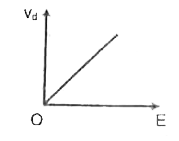if E denotes electric field in a uniform conductor and the corresponding drift velocity of free electrons in the conductor, then which of the following graph is correct




The correct Answer is:A
To solve the question regarding the relationship between the electric field (E) in a uniform conductor and the drift velocity (v_d) of free electrons, we can follow these steps:
1. Understanding the Relationship:
The drift velocity (v_d) of free electrons in a conductor is directly proportional to the electric field (E) applied across the conductor. This relationship can be expressed mathematically as:
vd∝E
2. Expressing the Proportionality:
We can write the proportionality in a more formal way:
vd=kE
where k is a constant of proportionality that depends on the material and the number density of free electrons.
3. Graphical Representation:
Since vd is directly proportional to E, the graph of vd versus E will be a straight line that passes through the origin. This indicates that when there is no electric field (E = 0), the drift velocity (v_d) is also zero.
4. Identifying the Correct Graph:
From the options provided, we need to identify the graph that shows a straight line passing through the origin. This will be the graph that correctly represents the relationship between drift velocity and electric field.
5. Conclusion:
Based on the analysis, the correct graph that represents the relationship between vd and E is the one that is a straight line starting from the origin. Therefore, the correct answer is option A.
The drift velocity (v_d) of free electrons in a conductor is directly proportional to the electric field (E) applied across the conductor. This relationship can be expressed mathematically as:
vd∝E
We can write the proportionality in a more formal way:
vd=kE
where k is a constant of proportionality that depends on the material and the number density of free electrons.
Since vd is directly proportional to E, the graph of vd versus E will be a straight line that passes through the origin. This indicates that when there is no electric field (E = 0), the drift velocity (v_d) is also zero.
From the options provided, we need to identify the graph that shows a straight line passing through the origin. This will be the graph that correctly represents the relationship between drift velocity and electric field.
Based on the analysis, the correct graph that represents the relationship between vd and E is the one that is a straight line starting from the origin. Therefore, the correct answer is option A.
Similar Questions
Matals are all good electrical conductors, Which of the following statements is correct ?
View SolutionE denotes electric field in a uniform conductor, I corresponding current through it, vd velocity of electrons and P denotes thermal power produced in the conductor, then which of the following graph is correct?
View SolutionWhen current flows through a conductor, then the order of drift velocity of electrons will be
View SolutionThe average velocity of electrons in a conductor in the absence of electric field is
View SolutionWhen electric field inside a conductor is E, mobility of free electrons inside the conductor is μ. When the electric field is doubled mobility will be
View SolutionState Ohm' law and deduce it from the knowledge of drift velocity of free electrons in a conductor carrying current.
View SolutionA proton and an electron are placed in a uniform electric field. Which of the following is correct?
View SolutionIf n,e,A and vd are free electron density inside conductor , charge of electron , area of cross-section of conductor and drift velocity of free electrons inside conductor, then current l through the conductor is
View SolutionDerive the expression for drift velocity of free electron in terms of relaxation time and electric field applied across a conductor.
View SolutionDerive the expression for drift velocity of free electron in terms of relaxation time and electric field applied across a conductor.
View Solution